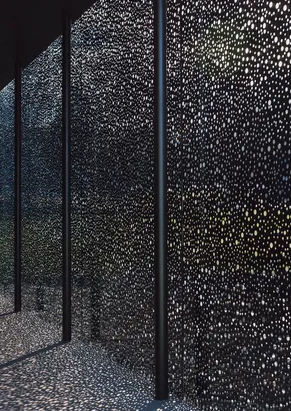The design enables a multiplicity of readings, leaving space for the visitor to participate in the meaning of the memorial, collaboratively, and with empathy.
Andrew Burns, An empathetic act: For Our Country, ArchitectureAu, 6 Oct 2020
The ambiguous object persists in contemporary architecture, in forms with intense specificity of siting, geometry and materiality, but without explicit narrative or reference. Underpinned by rigour but avoiding didacticism, such works enable multiple readings, opening space for the visitor to consider and participate in the meaning of the project. Through careful calibration and awareness of deeper modes of recognition, it is possible to build associations, both formal and spatial, into the work that are triggered by bodily response. The meaning is then undeniably present, but underneath the surface.
For Our Country, a memorial work undertaken by Kudjala/Gangalu/Kuku Yalanji/Waka Waka/Gubbi Gubbi/Wangerriburra/Bandjalung artist Daniel Boyd in collaboration with Kim Bridgland and Aaron Roberts of architecture practice Edition Office, exemplifies the ambiguous object approach to design. Located on Ngunnawal Country, the project holds multiple meanings, becoming a memorial to Indigenous service within the Australian military, while simultaneously holding potential as a place of knowledge sharing and ceremony beyond formal military memorial.

Meaning is embedded in the work through multiple subtleties. The project comprises a small pavilion, located at the edge of a circular stone field 11 metres in diameter. The stone field acts as a forecourt, imbuing the pavilion with an institutional potency or micro-civic quality. Basalt shards described by Bridgland as “nascent spear tips” form the ground surface, referencing the 60,000-year history of fabrication of tools and weapons to hunt and protect Country. In the centre of the field, a cast bronze dish is a place for lighting ceremonial fires and smoking ceremonies. Set within the dish, a small hole opens to a submerged ceremonial chamber for the collection of soil from Aboriginal and Torres Strait Islander communities across the country. In this way, each Indigenous nation can be commemorated in this place by contributing a piece of their Country to the memorial.
Geometric and material clarity define the project. A mirrored veil bisects the circular field, forming the eastern elevation of the pavilion and delineating an interior space. This screen is overlaid with a cloud of dots, characteristic of Boyd’s work. The dots become lenses – viewed from the interior they create an abstracted view outward across the surrounding lawns and treescape, capturing and softening eastern sun within the interior. “The thousands of clear lenses represent our perception, highlighting our incomplete understanding of time, history and memory,” explains Boyd. From the exterior, the mirrored glass of the dots becomes a reflective surface, again capturing the outlook across the surrounding landscape, fragmenting the view. From this viewpoint, the visitor is reflected in the surface, invited to see themselves within the work and creating what Bridgland describes as “a moment of empathetic exchange.”

The western perimeter of the space is composed of a black-pigmented rammed earth wall, capped by fine steel-plate detailing. The arcing wall holds a black-stained timber bench, suggesting an opportunity to pause. The concave geometry focuses the outlook towards the flame in the centre of the circular field. The reduced material palette and darkened tones remove the distraction of ambient light from the interior, intensifying the presence of flame and screen. This layering of material and geometric precision elevates the tone of the memorial, supporting the urgency of the artist and designers’ intent.
A radical act of scope redefinition underpins the project. Initially approached to submit a proposal for a sculptural work, Boyd sought to collaborate with Edition Office, sensing the opportunity to spatialize the sculptural brief to become a building, albeit one that is compact in footprint. The significance of this transformation is compounded by the fact that prior to For Our Country, no significant national Indigenous war memorial existed in Australia. By creating a building, however small, the artist and architects have given the memorial an institutional presence and opened a conversation; the memorial becomes a setting for truth-telling. Prior to the construction of this memorial, Indigenous diggers and their supporters would, on Anzac Day, walk up nearby Mount Ainslie to an informal gathering place anchored by a rock outcrop, the site of a small memorial plaque to Aboriginal and Torres Strait military service. In reference to this practice, the memorial is oriented eastward toward the Australian War Memorial and Mount Ainslie beyond.
My experience of the memorial leaves me with questions. What is the role of explicit reference in memorials and are there ways of holding together both explicit reference and open-ended meaning? Would the introduction of specific narrative content, such as stories of service or names of veterans, reduce the universality of the work, enabling it to appeal more intensely to a smaller number of visitors? For Our Country takes the approach of eschewing explicit reference in favour of open-endedness to enable broader resonances. The success of the project is achieved through this ambiguity, underpinned by precision and sincerity. It is a project that contributes, in a subtle, contained and collaborative way, to creating a society that cherishes Indigenous culture, understands the trauma of conflicts endured and acts empathetically to discover a shared future.
Credits
- Project: For Our Country
- Architect: Edition Office, Vic, Australia
- Project Team: Kim Bridgland, Aaron Roberts, Daniel Boyd
Consultants:
- Bronze casting UAP
- Builder RAM Constructions
- Glass supplier Clear Glass Solutions
- Glazing engineer
- Arup
- Rammed earth Olnee Constructions
- Structural engineer Farrar D
- Aboriginal Nation: For Our Country is built on the land of the Ngunnawal and Ngambri peoples.
- Site Details: Location Canberra, ACT, Australia.
Site type: Urban
Project Details:
- Status Built
- Completion date 2019
- Category Public/cultural
- Type Community
See also: https://www.awm.gov.au/visit/exhibitions/ForOurCountry

